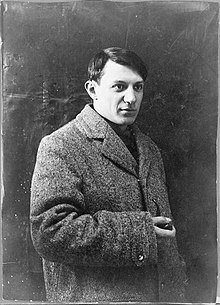Digging for Truth
Cézanne to Picasso: Ambroise Vollard, Patron of the Avant-Garde
During the research phase for my book, An Artist Empowered: Define and Establish Your Value as an Artist Now, I encountered many inaccuracies in books and films about art, art history, artists, success, and failure that were endlessly repeated. While an art dealer might say an exhibit was not a success, he may mean not enough pieces sold. Also, recollections are not immune to false memories.
Here is one example of such misinformation: The Object Lesson
The Metropolitan Museum of Art—NYC: 2007:
THE INVITE
Years ago, the Met had sent me a press pass for their exciting exhibit that included early works by Picasso. Art patron and dealer Vollard gave Picasso (then nearly a twenty-year-old) his first French exhibition (1901) in Paris.
Young man Pablo Picasso (1908) Remember, Pablo wasn’t born famous!
Ambroise Vollard | Art Dealer
I was especially interested in the Vollard—Picasso connection as I was writing a chapter titled “Picasso Unplugged” for my book, An Artist Empowered. There was so much misinformation in books and films about Picasso that my aim was to research firsthand information, not hand me down regurgitated fabricated stories.
Metropolitan Museum of Art, NYC (2007) CÉZANNE TO PICASSO: AMBROISE VOLLARD, PATRON OF THE AVANT-GARDE | eden maxwell
NOT THE FATE OF VAN GOGH
One film in particular (and books, too) about Picasso told of how his first Vollard exhibit was a total failure—not one piece sold. Picasso, they said, was so dejected at the time that he felt his life would go the tragic way of Van Gogh.
Marilyn McCully includes a different picture in her book, a Picasso anthology. Picasso’s friend and aspiring poet, Max Jacob, wrote in 1901 about their meeting in Paris. “As soon as he had arrived in Paris, he had an exhibition at Vollard’s, which was a veritable success. He was accused of imitating Steinlen, Lautrec, Vuillard, van Gogh, etc., but everyone recognized that he had a fire, a real brilliance, a painter’s eye.”
Picasso: The Man and His Work
In his 1974 documentary, Picasso: The Man and His Work, Edward Quinn (1920-1997) had the rare opportunity to photograph and film Picasso in his everyday life, at home and at work. Quinn’s intimate legacy chronicles Picasso’s career from the beginning to his last years and his passion for working until his death at the age of ninety-one on April 8, 1973, at Notre-Dame-de-Vie (Our Lady of Life), his hilltop villa at Mougins on the French Riviera.
Although the film was released a year after Picasso’s death, we may speculate that he did see a rough cut. In return for exclusive access to the artist, it isn’t unlikely that Picasso might have retained control over the content and the right to sign off with his approval on the documentary. Early on in the film, we learn that when the Spaniard Pablo Picasso was a young man in Paris, he met the art dealer Ambroise Vollard, who owned a progressive gallery. In June of 1901, Vollard included some of Picasso’s work in an exhibition, which, according to the film’s narrator, was a financial disaster—not a single painting sold. Then, we are told that not long after, as little interest was shown in his work, Picasso felt he would suffer the same fate as van Gogh, who never sold anything.
Note: I contacted the estate in Switzerland handling the Edward Quinn Archives, but they couldn’t tell me who, if anyone, had fact-checked the film. Regardless, Picasso didn’t correct Quinn. And why should he? As told, the drama of the event added more pathos to the ever-evolving fabrications and cachet of the artist’s image.
Metropolitan Museum of Art, NYC (2007) eden maxwell
MASTER OF PUBLICITY
Picasso biographer John Richardson also confirms that the Vollard exhibit was far from the bleak failure expressed in Quinn’s film. “Nevertheless, the Vollard exhibit was a stunning bravura performance for a neophyte, and it included some brilliant tours de force. Mañach’s insistence on saleability paid off: the show was not only a succès d’estime; it was, in a modest way, a financial success. Well over half the items sold. ‘[The Vollard show] went very well,’ Picasso said many years later. ‘It pleased a lot of people …’
Pablo was also known to contradict himself, as he once remarked that his 1901 Vollard Exhibit was a success.
Aside from Picasso’s talent, he was also a master of branding and publicity. He encouraged stories that lent power to the struggles of his art life, consequently attracting dealers, patrons, and others who spoke highly of his art. Remember, Pablo wasn’t born famous!
TRUTH REVEALED
I dug deeper still with the help of the Met Exhibition.
Curator Gary Tinterow provides us with a fresh and astute observation in the Cézanne to Picasso exhibition catalogue: “While Picasso and Mañach must have been thrilled with the effusive press and promising sales, Vollard, accustomed to the steady movement of paintings by Cézanne and Gauguin at substantial prices, understandably thought little of the effort. … From Vollard’s perspective in 1901, the Picasso–Iturrino exhibition was no different from any of the fleeting exhibitions he hosted that were devoted to other artists to whom he had no personal commitment …”
It turned out that Vollard had sold a few of the young Picasso’s paintings at that first show. That enlightening bit of news cast a shadow on the apocryphal “failure” story, often repeated as true by so-called experts. Certainly, for an unknown artist at the time, selling a few works right off would have been a good thing, then and now.
The object lesson: If you want depth, you must dig deep.




